Chapter Three
Sources + Folk Influences
Zhou Long, Herb Alpert Artist, 2001
Zhou Long:
I would like to know more about your recent works, especially in relation to your love of folk music. What kind of folk music strongly influenced your creative work?
JW:
In my piece “With a blue dress on” I was inspired by Appalachian fiddling. I listen to a lot of fiddlers, to how they retune the instrument to work with open strings, how they use the bow to make a beautiful raw sound. I wanted to add singing in bits - like fragments of a song bursting in unexpectedly. I worked with the song “Pretty little girl with a blue dress on” playing a feminist approach with a badass tough girl treatment of “pretty little girl” and wild virtuosic fiddling. I attended the Mark O’Connor fiddle camp in Bern, Tennessee a few years back where I heard the fiddler Bruce Molsky, whose singing, retuning, and playing inspired me. Darrel Anger was there as well, playing his gritty rhythms with his infamous “chop” strokes. I play mountain dulcimer and my very first string quartet, “Four Marys,” is an homage to the instrument - the wonderful drones and crying sound.
Other Influences
Lukas Ligeti, Herb Alpert Artist, 2010
Lukas Ligeti:
The first piece of yours I heard, nearly 25 years ago, was called “The Vermeer Room." Is visual art a constant influence for you, and if so, how?
JW:
Even this piece has a story attached. Vermeer painted the very beautiful image of a girl sitting at a table sleeping with her head resting against her hand. To her right is an illuminated doorway. The painting has been x-rayed; at one point there was a figure of a man in the doorway but Vermeer painted over it. This seemed very mysterious to me and I thought about things hidden in the painting. Even the girl’s sleep could be drenched in sound - but we don’t hear it.
My process in writing the piece involved taking things away, making space and light in different ways. There was also the Dutch connection as it was commissioned by the Rotterdam Arts Council and written for a young Dutch group. “The Vermeer Room” was my first commissioned work. I have only one other piece directly inspired by a painting. My orchestra work “Window of Vulnerability” was inspired by the work of painter Richard Diebenkorn - his depth perception, blocks of color, bold abstract landscape.
Other visual arts connections are with film. I scored pieces to the films of early experimental filmmaker Charles Dekekeliere – “Impatience,” and “Combat du Boxe” - both pieces commissioned by the Asko Ensemble. I collaborated with filmmaker Bill Morrison on the piece “Fuel” for the string orchestra Ensemble Resonanz, with comic book artist Ben Katchor on the comic book opera “The Carbon Copy Building,” with projection designer Jeff Sugg on “Anthracite Fields.”
Other visual collaborators include director Anne Bogart, scenic inventor Jim Findlay, director Francois Girard, choreographer Susan Marshall, and artist Laurie Olinder, among others.
Irene Borger:
I’m quoting from you here, Julie. “In 1997 I got a call from theater artist Anna Deveare Smith. She asked if I would write music for her new project, House Arrest. Thus began my journey into Anna’s world of interviews and realizations of characters in a fascinating documentary theater form. I created music out of chopped up interviews, speeches, violins, beats, and camera clicking. It was a tremendous experience to work within Anna’s creative process. Her work influenced “Steel Hammer” and “Anthracite Fields.””
Any influence as well from maybe Steve Reich’s “It’s gonna rain?”
JW:
Yes, Reich’s works, both the early tape pieces like “It’s gonna rain” and “Come out,” as well as large-scale works like “The Cave” and “Three Tales,” changed me.
Vijay Iyer, Herb Alpert Artist, 2003; panelist, 2006
Vijay Iyer:
Who is your favorite musician of color?
JW:
Up-and-coming composer Kendall Williams is a super talent. He combines his extensive experience as a steel pan virtuoso and bandleader with an interest in chamber music and writing for orchestra. His fusion is unique and really thrilling.
Performances + Desires
John King, Herb Alpert Artist, 2009
John King:
What brings you the most happiness when hearing a piece of your music performed for the very first time?
JW:
There have been a bunch of performances recently of my string orchestra works “Cruel Sister” and “Fuel.” There’s a real physicality to these works and when I watch and listen I can feel the energy in my body. This is always very exciting to me - both the athleticism and the group energy.
Irene Borger:
What do people need to “know” when they listen to music? How do you reach out (and make a bridge)? I remember you and Michael (composer Michael Gordon) telling me I could just listen directly…
JW:
I don’t think that the listener needs to know anything in particular before hearing a piece. But sometimes some insight can offer a window in. In the end the music should be a complete experience by itself - regardless of whether you read program notes.
IMB:
Surely people who play music or know a lot about music, music history, theory…can hear much more than someone, maybe with an undeveloped ear for listening to structure, and with a naturally wandering mind, who simply likes to go to concerts; would you say more?
JW:
Music offers the listener many things. Listening to music can be a transcendent experience. Because I have a powerful experience with music I believe others can and do have this experience as well. Music is often perceived as a specialized language, but listening need not require special education. Do people need to understand filmmaking to have a deep experience watching a film or do they need to understand the fundamentals of choreography to be transported by the dance? I don’t think so.
Chen Yi, Herb Alpert Artist, 1997
Chen Yi:
Would you like to do a creative project that you had dreamt to do but haven't had a chance to do yet?
JW:
My first sensation when reading the question was that I feel so fortunate to have had so many dream opportunities. Sometimes I have to pinch myself, and at other times have to stop myself in my tracks to appreciate how wonderful it is to be composing and working with great musicians. I remember thinking that I don’t want to just respond to commissions that come my way. I am always grateful for interest in my music, but I want to feel that I am directly shaping my direction. I think up projects that interest me and then begin discussions with performers, organizations, and venues about how to realize the project. There was a point when I recognized that I wanted to tap into a certain sound and a way of working with narrative that is very open.
By open I mean representing an idea or story without it being specifically linear or literal. That is how both “Steel Hammer” and “Anthracite Fields” came about. I thought - what is it that I need to do? need to say? - And then I began conversations with people. My interest in American labor history continues to be a strong focus. In upcoming works I have turned my attention to women in the work force; they include a new evening length piece for cellist Maya Beiser, with visuals by Laurie Olinder, on the art of spinning thread. I also have a longer-term large-scale project for orchestra and chorus that involves research - lots of reading, site visits, interviews coming up.
Stay tuned!
***
""Music is often perceived as a specialized language, but listening need not require special education.""

"Shelter" is a collaboration between composers Julia Wolfe, Michael Gordon, David Lang, and writer Deborah Artman.

"Lost Objects" is a collaboration between composers Julia Wolfe, Michael Gordon, David Lang, and writer Deborah Artman.





